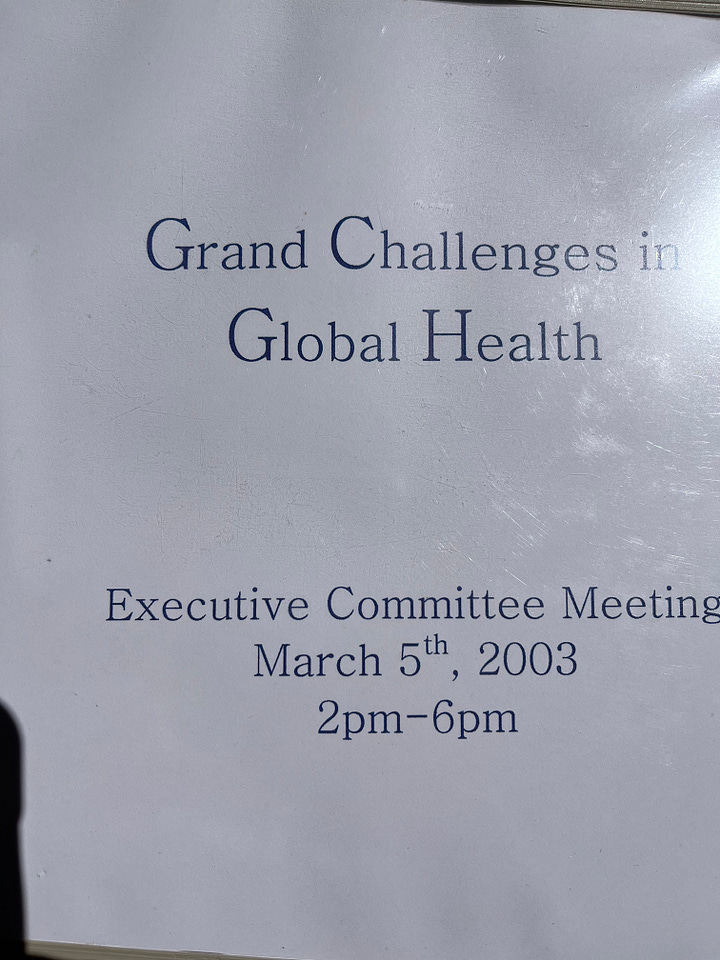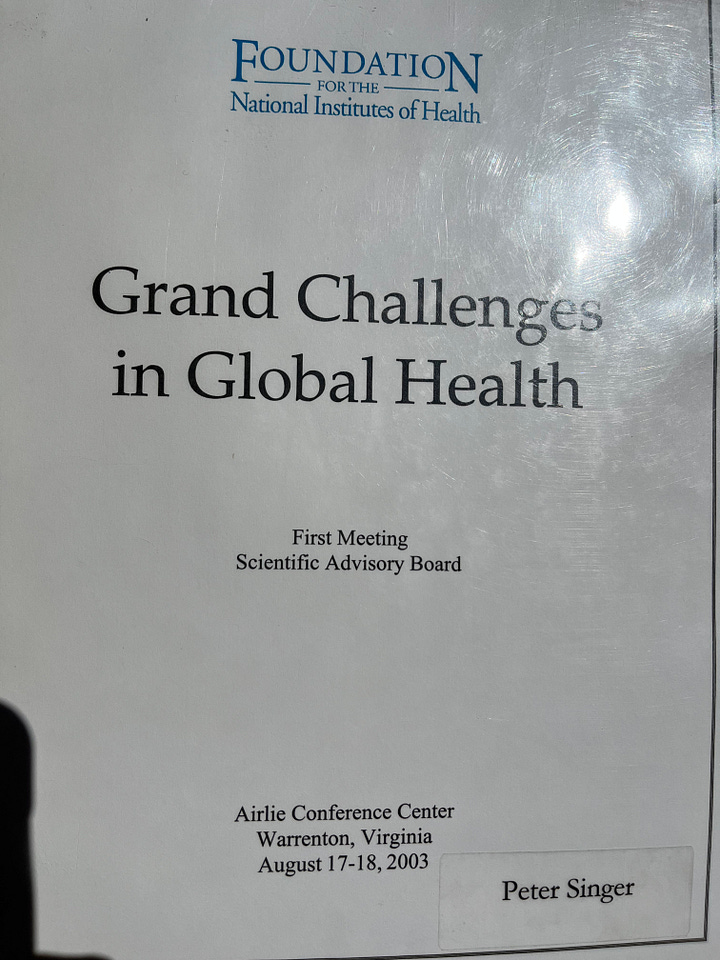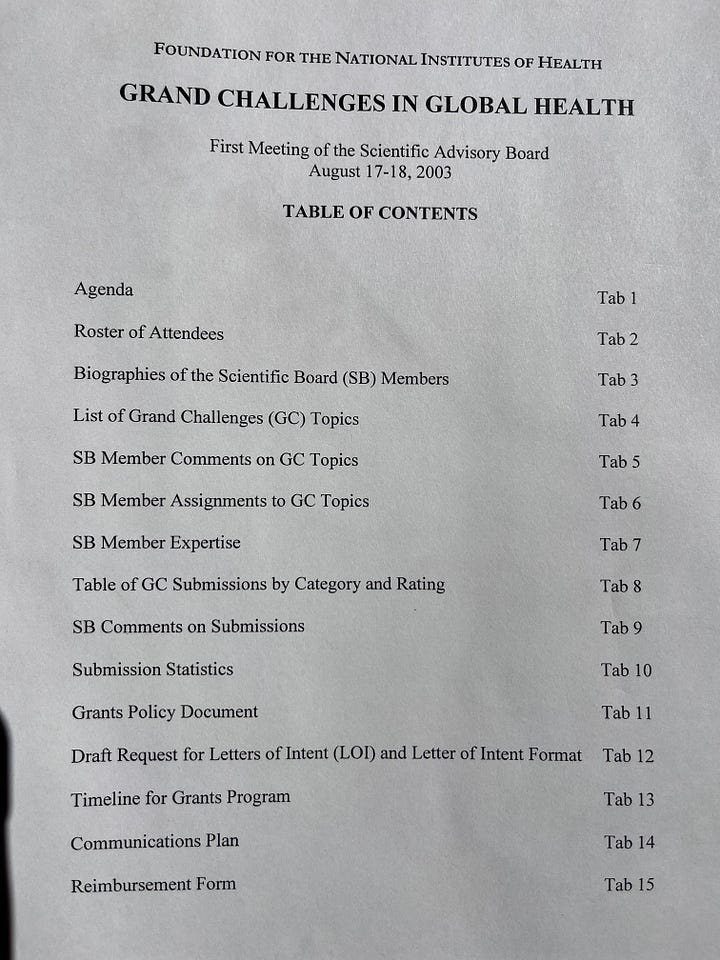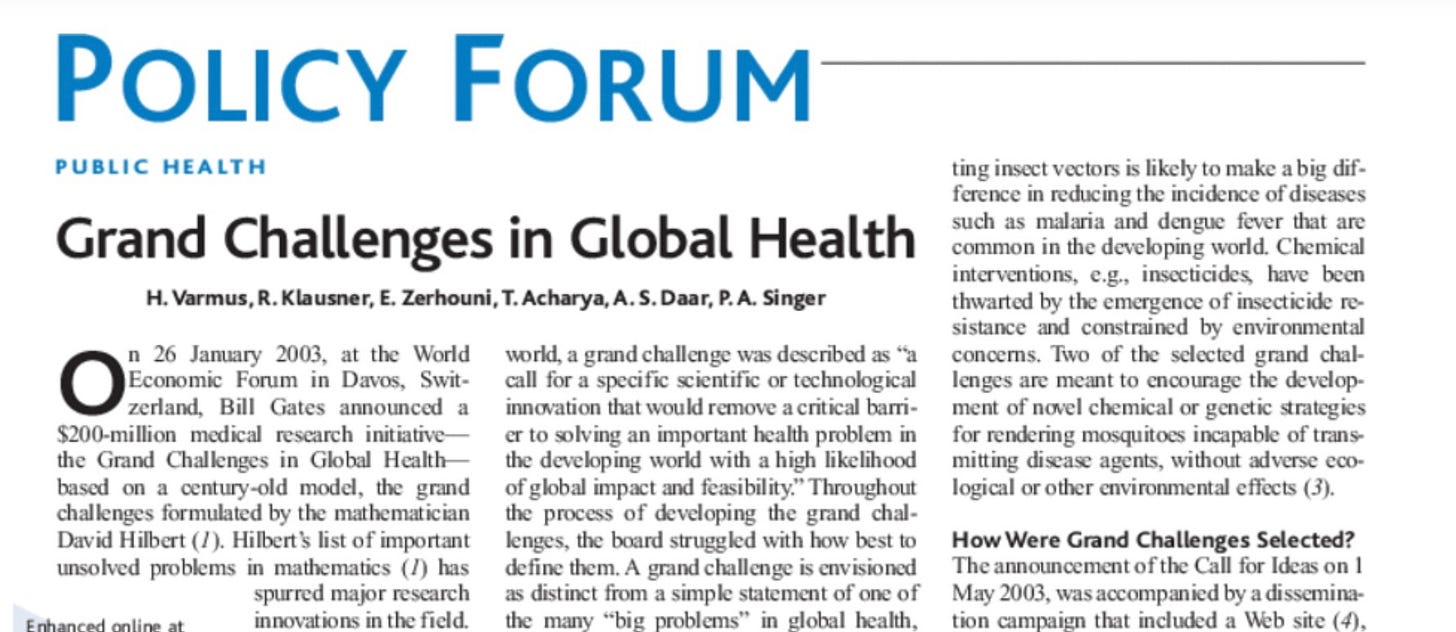How innovation can speed up the Sustainable Development Goals: implementation, implementation, implementation!
This week I am travelling to Senegal to celebrate the 20th anniversary of Grand Challenges, a happy moment for me since I had the privilege to help launch the initiative. I also had the privilege of serving for six years in WHO as Dr. Tedros’ Special Advisor. These experiences led me to reflect further on how innovation can speed up the Sustainable Development Goals (SDGs).
At their midpoint, the SDGs, the world’s blueprint to 2030 agreed by all countries in 2015, are badly lagging, with only 15% on track. In the case of Universal Health Coverage, we must double the pace to reach the 2030 target.
At the recent SDG Summit and related meetings on health and climate, it was good to see the focus on a limited number of specific, SDG based “transitions” — energy compacts, biodiversity and nature, transforming education, social protection and jobs, food systems (plus universal health coverage and pandemic preparedness) — with coalitions and strategies developed around each.
I was pleasantly surprised at the strength of political recommitment to the SDGs. It was inspiring to see youth leaders, civil society, mayors, and business leaders demanding action, and holding political leaders to account. There were promising discussions on the Secretary-General’s SDG Stimulus of $500 billion per year and reform of the international financial architecture.
But no amount of doubling down on specific topics (“transitions”) — even with political commitment and finance — will be enough to reach the SDGs. To accelerate SDG progress, our mantra for the second half must be: implementation, implementation, implementation.
I believe the UN and its agencies can do much more to help countries to implement and speed SDG progress using innovation.
What I see is a classic case of the whole could be so much more than the sum of the parts: by improving innovation in the UN and marrying the pipeline of innovations from Grand Challenges and other sources (the ‘supply’ side) with the country platforms and accelerators of UN agencies (the ‘demand’ side), we would have a system that helps the world to reach the SDG targets by 2030.
Grand Challenges
In late 2002, before the launch of the Grand Challenges in Global Health, I received a call from Rick Klausner, then head of Global Health at the Gates Foundation. In March 2003, I found myself in a small, unmarked office in Washington helping the Gates Foundation design the Grand Challenges. In August 2003, my my dear friend Abdallah Daar and I were supporting the Scientific Board (which I later joined) to shape the Grand Challenges in Global Health. In October 2003, these were published in Science, and supported with an initial $482 million. In 2010, we launched Grand Challenges Canada, around the same time as the US Government launched USAID Grand Challenges. Thus began a sea-change in using science and innovation in international development. (Abdallah and I describe this early history in our book, The Grandest Challenge.)




Twenty years later, billions of dollars have supported thousands of innovations, based on dozens of challenges. Although the Bill & Melinda Gates Foundation deserves great credit for initiating Grand Challenges and supporting the community for two decades, Grand Challenges is not equal to Gates Foundation — but rather a thriving community of dozens of innovation funders and thousands of innovators working together for development impact.
The most obvious way to measure success of the Grand Challenges is by the impact of its projects. This will be a focus of the 20th Anniversary meeting in Senegal. I won’t steal their thunder here.
There were big bets that paid off, such as the World Mosquito Programme which has reduced dengue incidence in several communities.
Not only home runs but also the ‘doubles’ and ‘triples’ count. One can see this by comparing the technology-based toilet challenge with the many social enterprises supported to provide innovative and context-specific services for water and sanitation.
The grand challenges approach has been applied to a range of themes, spanning from Saving Lives at Birth, Saving Brains, mental health, non communicable diseases, to antimicrobial resistance, artificial intelligence, to humanitarian and indigenous innovation, and much more. USAID deserves credit for expanding early the grand challenges to energy, food, education, and democracy.
The methods used are not only technological innovation but also social / service delivery innovations, often digitally enabled and or supported by an innovative business model. (We called this ‘integrated innovation’ right from the start of Grand Challenges Canada.) One sees this in mental health innovations such as Friendship Bench or SEEK-Group Psychotherapy.
Financial innovation helps. For example the $100 million+ Global Health Investment Fund supported EuBiologics to develop and distribute over 50 million doses of cholera vaccine, which through competition helped drop the price and the company had a successful IPO. Other examples are TeamFund, Cross Border Impact Ventures, and Transform Health Fund.
The SDGs are only as good as the people solving them. I remember walking in 2003 with Elias Zerhouni and asking him: how will we judge success? His answer: the scientists who work on global health when they otherwise wouldn’t. I frequently meet innovators whose lives were changed by grand challenges support.
Leadership of innovators from low and middle income counties has been pivotal. To take just one example, an Indian company, Molbio, which is now valued at $1.6 billion, developed a PCR test originally for Tuberculosis and now widely used for COVID-19 and many other diseases.
I think the most significant contribution is the Grand Challenges network and the new initiatives and organizations that have been formed in low and middle income countries such as Grand Challenges Brazil, China, India, South Africa, Ethiopia, Malawi, Rwanda, Senegal, and Africa-wide, as well as in the US, Canada, Korea, Israel, and more. This democratizes innovation and has the potential to power prosperity and jobs.
The weakness of Grand Challenges is the path to scale. About 100 innovations have reached one million people, but to move the needle on the SDGs these will need to be scaled to tens or hundreds of millions.
Why is there no systematic path to scale? Because nothing is more powerful in scaling innovation than the pull of demand from countries. At the moment, country demand is not well connected to the pipeline of mature innovations. As they say, you cant push a string! That is where the UN, an organization comprised of 193 country governments, and its specialized agencies, comes in.
UN 2.0
In September 2023, the UN launched UN 2.0, which is about “strengthening our expertise and culture in data, digital, innovation, foresight, and behavioural science – to build a UN System that can better support Member States in the years to come." I ❤️ UN 2.0 because it’s the right strategic direction, but it needs implementation, building in a practical way on what the agencies are doing.
In 2018, before UN 2.0, WHO’s current strategy, the 13th General Programme of Work, identified scaling up innovation as a key role for WHO:
Based on its close relationships with governments, WHO can take a unique role in catalysing the scaling up and sustainability of effective, health innovations. By linking innovations, innovators, and innovation funders with governments, WHO can catalyse the sustainable scaling up of evidence-based innovations within health systems.
Implementation is in the WHO innovation hub and a focusing example is how the hub, working with the WHO Representative and country office, brought together an innovation, innovator, innovation funder and government was solar powered oxygen, which is saving children’s lives in Somalia. The hub is currently working with Grand Challenges Canada, which is in official relations with WHO, to scale other innovations in primary health care, mental health, and reproductive, maternal, newborn and child health, and more.
The Health Innovation Exchange, launched by UNAIDS in 2019, “connects countries and systems, identifies their health-specific priorities or challenges, and works to ensure that investments are channeled to support high-potential innovations for health that help countries move towards impact for the SDGs.” Examples include speech digital bio marker technology that diagnoses behavioural health conditions, and 3D “smart” intrauterine drug-delivery technology.
WFP Innovation Accelerator pilots and scales promising ideas by leveraging advances in digital innovation. Examples include an AI satellite imagery tool which assesses damage and coordinates disaster response within 24-28 hours, and EMPACT which empowers students (54% female) by providing them with essential skills to become part of the global digital economy.
UNDP Accelerator Labs, which “celebrate grassroots innovations that move us towards a more sustainable planet,” are supporting 115 countries. Examples include digitization of a traditional savings scheme in South Sudan, capturing data for climate resilient agriculture in India, and using “elegant grasshoppers” as a pesticide in Lesotho. This blog tells the story.
UNICEF’s supply division drives product innovation using procurement. For example, the group recently launched an Advance Purchase Commitment of $8+ million to incentivize the development of a durable, energy efficient oxygen concentrator for low-resource settings.
More established accelerators outside the UN could become partners in an effort to speed up SDGs, such as Villgro, founded in 2001. And accelerators are complemented by mission oriented initiatives, such as the TB vaccine accelerator council, mRNA vaccine hub, digital public infrastructure, and organizations such as CEPI, UNITAID, and Medicines Patent Pool.
There have been efforts to more closely align the work of the UN and other multilateral agencies on innovation, for example in SDG 3 Global Action Plan. In a useful but not widely read report, a group of Yale students described the innovation activities of 13 agencies.
The reality is that innovation faces major barriers in UN agencies. Some want to focus on science instead of innovation: we need both. Some see innovation as organizational culture: it is but the most likely source of innovations already reaching hundreds of thousands or millions that would be scaled by 10x is outside the agencies. Normative agencies have difficulty focusing on specific innovations: but innovations scale one at a time. Some want to focus on seed innovations: but the comparative advantage of the UN system is scale. While thematic technical units, often found in HQ have the power and money, the country offices are more important in scaling innovations. There are few entrepreneurs in UN agencies (I have called for more of these ‘diplo-preneurs’), and those who are there often feel frustrated.
What can UN agencies do to speed up SDGs using innovation? Elevate the innovation accelerators / hubs in the agencies, with more budget and support from the head of agency. Recruit and support diplo-preneurs. Support and train UN Resident Coordinators and heads of agency country offices to lead on innovation. Make the various accelerators a more coherent system across the UN — and apply specific accelerators against specific transitions and SDGs — without stifling their individual leadership, creativity and drive. And marry this UN 2.0 innovation system to the grand challenges innovation community.
Marrying Grand Challenges and UN 2.0 to speed up the SDGs
Marrying the grand challenges to UN 2.0 would be a concrete step towards speeding up the SDGs.
The focus: identify innovations relevant to the thematic transitions from the SDG Summit (plus health and climate) that are currently reaching a few hundred thousand or million people and scale them to tens or hundreds of millions of people.
As mPESA has shown, it doesn’t take a lot of innovations to make a big difference. At the digital transformation event at the SDG Summit, one innovation for each SDG was presented. More of this please!
The marriage of grand challenges (and other innovation pipelines) with UN 2.0 must learn from past efforts. For example, the pioneering International Development Innovation Alliance counts WHO, UNICEF, the Global Finance Facility of the World Bank, and OECD as members/partners, alongside innovation funders. Its members share valuable lessons and it inspired the Million Lives Collective which focuses on specific innovations.
Another example is the Every Woman Every Child Innovation Marketplace. Arising from a UN initiative, the innovation marketplace was a partnership of four development innovation funders. It supported individual innovations which mobilized US $48 million, evaluated 375 innovations and endorsed 26 of these which reached 23 million end users resulting in more than 18,000 lives saved and 760,000 lives improved. Unlike almost every other initiative in global health, this one actually shut down and extensively documented its lessons, which will be vital for UN 2.0 and the marriage with grand challenges.
An example of setting goals on innovation was provided by Dr Tedros, when he set a goal for WHO of scaling 5 innovations to 5 million people each within 5 years.
In September 2024 the UN will hold the Summit of the Future. I respectfully call upon the co-facilitators (Germany and Namibia) and all governments championing innovation, as well as the UN Executive Office of the Secretary General and the heads of UN agencies, to implement this practical proposal, building upon UN 2.0, to speed up the SDGs.





I couldn’t agree with you more. I would add two other words to “implementation”, those are “scale” and “governance”.
We many great examples of potentially transformative innovations but scale ups are what truly disrupt and transform.
On governance, unless these solutions and approaches are strategically integrated into ways of working, then it’s always an uphill battle.
The biggest challenge I feel we face is not a battle for new innovations but a battle for minds (particularly leadership) that are willing to embrace them.
Great insights on the role of innovation in accelerating sustainable practices! It's inspiring to see how technological advancements and creative thinking can reshape our approach to environmental challenges. Emphasizing collaboration between sectors can lead to impactful solutions. Looking forward to seeing how these innovations unfold in real-world applications!
Website:- https://www.evigrxplus.com/united-states/